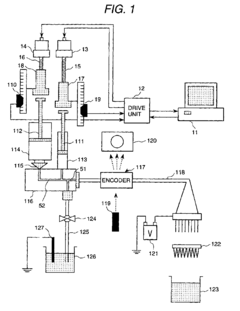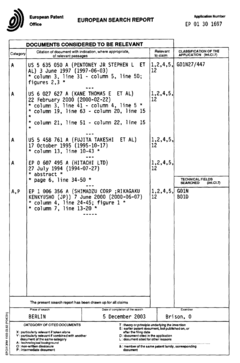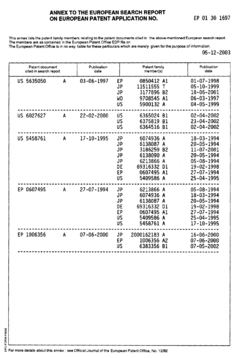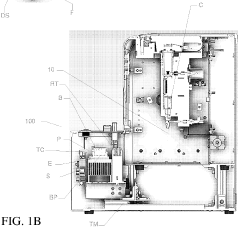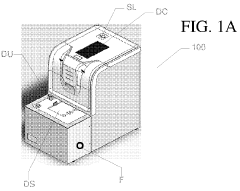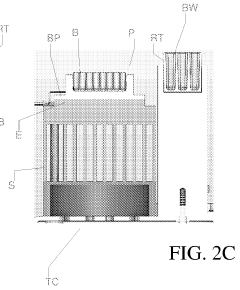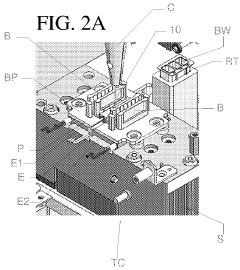Gel Electrophoresis in Forensic Science: Key Innovations
JUN 30, 20259 MIN READ
Generate Your Research Report Instantly with AI Agent
Patsnap Eureka helps you evaluate technical feasibility & market potential.
Forensic Gel Electrophoresis Background and Objectives
Gel electrophoresis has been a cornerstone technique in forensic science for decades, revolutionizing the analysis of DNA evidence. This method, which separates molecules based on their size and electrical charge, has undergone significant advancements since its inception in the 1960s. The primary objective of forensic gel electrophoresis is to provide accurate, reliable, and legally admissible DNA profiling results for criminal investigations and legal proceedings.
The evolution of gel electrophoresis in forensic science has been driven by the need for increased sensitivity, specificity, and efficiency in DNA analysis. Early applications relied on agarose gels, which offered limited resolution and required large sample sizes. However, the introduction of polyacrylamide gels in the 1970s marked a significant improvement, allowing for the separation of smaller DNA fragments with higher resolution.
A major milestone in the field was the development of Restriction Fragment Length Polymorphism (RFLP) analysis in the 1980s. This technique, combined with Southern blotting, enabled forensic scientists to identify specific DNA sequences and create unique genetic profiles. However, RFLP analysis required relatively large amounts of DNA and was time-consuming, limiting its applicability in cases with degraded or minimal DNA samples.
The advent of Polymerase Chain Reaction (PCR) in the mid-1980s transformed forensic DNA analysis. PCR amplification allowed for the analysis of minute DNA samples, greatly expanding the range of evidence that could be processed. This led to the development of Short Tandem Repeat (STR) analysis, which became the gold standard for forensic DNA profiling due to its high discriminatory power and compatibility with automated systems.
Recent technological trends in forensic gel electrophoresis focus on enhancing speed, sensitivity, and automation. Capillary electrophoresis, a variant of gel electrophoresis, has gained prominence due to its ability to provide high-resolution separation with minimal sample requirements. Additionally, microfluidic devices and lab-on-a-chip technologies are emerging as promising platforms for rapid, on-site DNA analysis in forensic applications.
The ongoing objectives in forensic gel electrophoresis research include developing methods for analyzing highly degraded DNA, improving the resolution of mixed DNA samples, and reducing the time and cost of analysis. There is also a growing emphasis on integrating gel electrophoresis with other analytical techniques, such as mass spectrometry, to enhance the information obtained from forensic samples.
As the field continues to evolve, researchers are exploring novel materials and techniques to overcome current limitations. These include the use of nanomaterials in gel matrices for enhanced separation, the development of multiplex systems for simultaneous analysis of multiple markers, and the application of artificial intelligence for data interpretation. The ultimate goal is to create more robust, efficient, and versatile forensic DNA analysis tools that can meet the challenges of modern criminal investigations and withstand scrutiny in legal proceedings.
The evolution of gel electrophoresis in forensic science has been driven by the need for increased sensitivity, specificity, and efficiency in DNA analysis. Early applications relied on agarose gels, which offered limited resolution and required large sample sizes. However, the introduction of polyacrylamide gels in the 1970s marked a significant improvement, allowing for the separation of smaller DNA fragments with higher resolution.
A major milestone in the field was the development of Restriction Fragment Length Polymorphism (RFLP) analysis in the 1980s. This technique, combined with Southern blotting, enabled forensic scientists to identify specific DNA sequences and create unique genetic profiles. However, RFLP analysis required relatively large amounts of DNA and was time-consuming, limiting its applicability in cases with degraded or minimal DNA samples.
The advent of Polymerase Chain Reaction (PCR) in the mid-1980s transformed forensic DNA analysis. PCR amplification allowed for the analysis of minute DNA samples, greatly expanding the range of evidence that could be processed. This led to the development of Short Tandem Repeat (STR) analysis, which became the gold standard for forensic DNA profiling due to its high discriminatory power and compatibility with automated systems.
Recent technological trends in forensic gel electrophoresis focus on enhancing speed, sensitivity, and automation. Capillary electrophoresis, a variant of gel electrophoresis, has gained prominence due to its ability to provide high-resolution separation with minimal sample requirements. Additionally, microfluidic devices and lab-on-a-chip technologies are emerging as promising platforms for rapid, on-site DNA analysis in forensic applications.
The ongoing objectives in forensic gel electrophoresis research include developing methods for analyzing highly degraded DNA, improving the resolution of mixed DNA samples, and reducing the time and cost of analysis. There is also a growing emphasis on integrating gel electrophoresis with other analytical techniques, such as mass spectrometry, to enhance the information obtained from forensic samples.
As the field continues to evolve, researchers are exploring novel materials and techniques to overcome current limitations. These include the use of nanomaterials in gel matrices for enhanced separation, the development of multiplex systems for simultaneous analysis of multiple markers, and the application of artificial intelligence for data interpretation. The ultimate goal is to create more robust, efficient, and versatile forensic DNA analysis tools that can meet the challenges of modern criminal investigations and withstand scrutiny in legal proceedings.
Market Analysis for Forensic DNA Profiling Technologies
The forensic DNA profiling technology market has experienced significant growth in recent years, driven by advancements in gel electrophoresis techniques and increasing demand for accurate and efficient forensic analysis. This market segment is expected to continue its upward trajectory, with a projected compound annual growth rate of over 13% from 2021 to 2026.
The primary factors fueling market expansion include rising crime rates, growing awareness of DNA evidence in legal proceedings, and increased government investments in forensic infrastructure. Additionally, the adoption of advanced DNA profiling technologies by law enforcement agencies and forensic laboratories worldwide has contributed to market growth.
Gel electrophoresis, a cornerstone technique in forensic DNA analysis, has seen substantial innovations that have enhanced its capabilities and market potential. These advancements have led to improved resolution, faster processing times, and higher sensitivity in DNA fragment separation, making it an indispensable tool in forensic science.
The market for forensic DNA profiling technologies can be segmented based on product type, application, and end-user. Product segments include instruments, reagents and consumables, and software. Among these, reagents and consumables hold the largest market share due to their recurring nature and essential role in DNA analysis processes.
Application-wise, the market is divided into criminal forensics, paternity testing, and other applications such as disaster victim identification. Criminal forensics remains the dominant application segment, driven by the increasing use of DNA evidence in criminal investigations and court proceedings.
End-users of forensic DNA profiling technologies primarily include law enforcement agencies, forensic laboratories, and research institutions. The law enforcement sector represents the largest end-user segment, with growing adoption of advanced DNA profiling techniques to solve complex criminal cases.
Geographically, North America leads the global forensic DNA profiling technology market, followed by Europe and Asia-Pacific. The United States, in particular, holds a significant market share due to its well-established forensic infrastructure and high adoption rate of advanced technologies. However, emerging economies in Asia-Pacific and Latin America are expected to witness rapid growth in the coming years, driven by increasing investments in forensic capabilities and rising awareness of DNA evidence in legal systems.
Key market players in the forensic DNA profiling technology sector include Thermo Fisher Scientific, QIAGEN, Promega Corporation, and Illumina, Inc. These companies are focusing on developing innovative products and expanding their geographical presence to maintain their competitive edge in the market.
The primary factors fueling market expansion include rising crime rates, growing awareness of DNA evidence in legal proceedings, and increased government investments in forensic infrastructure. Additionally, the adoption of advanced DNA profiling technologies by law enforcement agencies and forensic laboratories worldwide has contributed to market growth.
Gel electrophoresis, a cornerstone technique in forensic DNA analysis, has seen substantial innovations that have enhanced its capabilities and market potential. These advancements have led to improved resolution, faster processing times, and higher sensitivity in DNA fragment separation, making it an indispensable tool in forensic science.
The market for forensic DNA profiling technologies can be segmented based on product type, application, and end-user. Product segments include instruments, reagents and consumables, and software. Among these, reagents and consumables hold the largest market share due to their recurring nature and essential role in DNA analysis processes.
Application-wise, the market is divided into criminal forensics, paternity testing, and other applications such as disaster victim identification. Criminal forensics remains the dominant application segment, driven by the increasing use of DNA evidence in criminal investigations and court proceedings.
End-users of forensic DNA profiling technologies primarily include law enforcement agencies, forensic laboratories, and research institutions. The law enforcement sector represents the largest end-user segment, with growing adoption of advanced DNA profiling techniques to solve complex criminal cases.
Geographically, North America leads the global forensic DNA profiling technology market, followed by Europe and Asia-Pacific. The United States, in particular, holds a significant market share due to its well-established forensic infrastructure and high adoption rate of advanced technologies. However, emerging economies in Asia-Pacific and Latin America are expected to witness rapid growth in the coming years, driven by increasing investments in forensic capabilities and rising awareness of DNA evidence in legal systems.
Key market players in the forensic DNA profiling technology sector include Thermo Fisher Scientific, QIAGEN, Promega Corporation, and Illumina, Inc. These companies are focusing on developing innovative products and expanding their geographical presence to maintain their competitive edge in the market.
Current Challenges in Forensic Gel Electrophoresis
Gel electrophoresis remains a cornerstone technique in forensic science, particularly for DNA analysis. However, several challenges persist in its application to forensic investigations. One of the primary issues is the time-consuming nature of the process. Traditional gel electrophoresis can take hours to complete, which can be problematic in time-sensitive criminal investigations where rapid results are crucial.
Another significant challenge is the limited sensitivity of conventional gel electrophoresis methods. As forensic samples often contain minute quantities of DNA, there is a pressing need for techniques that can detect and analyze trace amounts of genetic material. The inability to consistently detect low-concentration DNA samples can lead to inconclusive results or missed evidence.
Sample contamination and degradation pose additional hurdles in forensic gel electrophoresis. Environmental factors, improper handling, or prolonged storage can compromise the integrity of DNA samples, making it difficult to obtain clear, interpretable results. This is particularly problematic in cold cases or when dealing with samples exposed to harsh conditions.
The resolution of DNA fragments, especially those of similar sizes, remains a challenge in forensic applications. Improved resolution is critical for accurately distinguishing between closely related individuals or identifying mixed DNA samples, which are common in forensic cases.
Standardization and reproducibility across different laboratories and equipment setups are ongoing concerns. Variations in gel composition, running conditions, and imaging techniques can lead to inconsistencies in results, potentially compromising the admissibility of evidence in court.
The interpretation of gel electrophoresis results in complex forensic scenarios, such as mixtures of DNA from multiple contributors, continues to be challenging. Current methods often struggle to accurately deconvolute these mixed profiles, limiting the technique's effectiveness in certain cases.
Automation and integration with other forensic techniques represent areas where gel electrophoresis lags behind more modern DNA analysis methods. The manual nature of many gel electrophoresis procedures increases the risk of human error and reduces throughput, which is problematic for forensic laboratories dealing with large caseloads.
Lastly, the advent of next-generation sequencing technologies has put pressure on gel electrophoresis to evolve and maintain its relevance in forensic science. While gel electrophoresis remains valuable for certain applications, there is a need for innovation to address its limitations and ensure its continued utility in the face of advancing DNA analysis technologies.
Another significant challenge is the limited sensitivity of conventional gel electrophoresis methods. As forensic samples often contain minute quantities of DNA, there is a pressing need for techniques that can detect and analyze trace amounts of genetic material. The inability to consistently detect low-concentration DNA samples can lead to inconclusive results or missed evidence.
Sample contamination and degradation pose additional hurdles in forensic gel electrophoresis. Environmental factors, improper handling, or prolonged storage can compromise the integrity of DNA samples, making it difficult to obtain clear, interpretable results. This is particularly problematic in cold cases or when dealing with samples exposed to harsh conditions.
The resolution of DNA fragments, especially those of similar sizes, remains a challenge in forensic applications. Improved resolution is critical for accurately distinguishing between closely related individuals or identifying mixed DNA samples, which are common in forensic cases.
Standardization and reproducibility across different laboratories and equipment setups are ongoing concerns. Variations in gel composition, running conditions, and imaging techniques can lead to inconsistencies in results, potentially compromising the admissibility of evidence in court.
The interpretation of gel electrophoresis results in complex forensic scenarios, such as mixtures of DNA from multiple contributors, continues to be challenging. Current methods often struggle to accurately deconvolute these mixed profiles, limiting the technique's effectiveness in certain cases.
Automation and integration with other forensic techniques represent areas where gel electrophoresis lags behind more modern DNA analysis methods. The manual nature of many gel electrophoresis procedures increases the risk of human error and reduces throughput, which is problematic for forensic laboratories dealing with large caseloads.
Lastly, the advent of next-generation sequencing technologies has put pressure on gel electrophoresis to evolve and maintain its relevance in forensic science. While gel electrophoresis remains valuable for certain applications, there is a need for innovation to address its limitations and ensure its continued utility in the face of advancing DNA analysis technologies.
State-of-the-Art Gel Electrophoresis Techniques
01 Gel composition and preparation
Various gel compositions and preparation methods are used in gel electrophoresis. These include specific formulations of polymers, cross-linking agents, and buffer solutions to create gels with desired properties for different applications. The composition and preparation of the gel can significantly affect the separation and resolution of molecules during electrophoresis.- Gel composition and preparation: Various gel compositions and preparation methods are used in gel electrophoresis. These include specific formulations of agarose, polyacrylamide, or other polymers to create gels with desired properties for different applications. The composition and preparation of the gel can significantly affect the separation and resolution of molecules during electrophoresis.
- Electrophoresis apparatus design: Innovations in electrophoresis apparatus design focus on improving efficiency, resolution, and ease of use. These designs may include novel electrode configurations, buffer systems, or sample loading mechanisms. Some apparatuses are designed for specific applications or to overcome limitations of traditional systems.
- Detection and analysis methods: Various detection and analysis methods are employed in gel electrophoresis to visualize and quantify separated molecules. These may include fluorescence-based detection, staining techniques, or integration with other analytical instruments. Advanced image analysis software and algorithms are often used to interpret electrophoresis results.
- Microfluidic and miniaturized systems: Miniaturized and microfluidic gel electrophoresis systems are developed to reduce sample volume requirements, increase throughput, and improve portability. These systems often integrate multiple functions, such as sample preparation and detection, into a single device. They may use novel materials or fabrication techniques to achieve miniaturization.
- Specialized applications: Gel electrophoresis techniques are adapted for specialized applications in various fields, including proteomics, genomics, and clinical diagnostics. These may involve modifications to the gel composition, running conditions, or detection methods to optimize separation and analysis of specific types of molecules or to meet particular research or diagnostic needs.
02 Electrophoresis apparatus design
Innovations in electrophoresis apparatus design focus on improving efficiency, resolution, and ease of use. These designs may include novel electrode configurations, buffer circulation systems, temperature control mechanisms, and integrated detection systems. Advanced apparatus designs aim to enhance the overall performance and versatility of gel electrophoresis systems.Expand Specific Solutions03 Sample loading and separation techniques
Various techniques are employed for sample loading and separation in gel electrophoresis. These may include methods for precise sample application, use of stacking gels, gradient gels, and pulsed-field electrophoresis. These techniques aim to improve sample resolution, prevent band distortion, and enable separation of a wide range of molecule sizes.Expand Specific Solutions04 Detection and analysis methods
Advanced detection and analysis methods are developed to visualize and quantify separated molecules in gel electrophoresis. These may include fluorescent labeling, chemiluminescence, colorimetric staining, and digital imaging techniques. Some systems incorporate real-time monitoring and automated analysis to enhance the accuracy and efficiency of results interpretation.Expand Specific Solutions05 Specialized gel electrophoresis applications
Gel electrophoresis techniques are adapted for specialized applications in various fields. These may include capillary gel electrophoresis, two-dimensional gel electrophoresis, and electrophoresis methods optimized for specific types of molecules such as proteins, nucleic acids, or small molecules. Specialized applications often require modifications to standard protocols to achieve optimal results.Expand Specific Solutions
Major Players in Forensic DNA Analysis Industry
The gel electrophoresis market for forensic science is in a mature growth stage, with a steady increase in market size due to ongoing advancements in technology and growing applications in criminal investigations. The global market is estimated to be worth several hundred million dollars, driven by the increasing demand for accurate and reliable DNA analysis in forensic laboratories. Key players like Life Technologies Corp., Agilent Technologies, and Beckman Coulter dominate the market, offering sophisticated systems and consumables. These companies, along with others such as Roche Diagnostics and Helena Laboratories, are continuously innovating to improve the speed, sensitivity, and resolution of gel electrophoresis techniques, enhancing their applicability in forensic science.
Agilent Technologies, Inc.
Technical Solution: Agilent Technologies has developed advanced gel electrophoresis systems for forensic science applications. Their 2100 Bioanalyzer system utilizes microfluidic technology to perform automated electrophoresis, providing high-resolution DNA separation and quantification[1]. This lab-on-a-chip approach allows for rapid analysis of DNA fragments with minimal sample consumption. Agilent has also introduced the Fragment Analyzer system, which offers higher throughput and sensitivity for forensic DNA profiling[2]. These innovations have significantly improved the speed and accuracy of DNA analysis in forensic investigations.
Strengths: High-resolution DNA separation, automated analysis, minimal sample requirements. Weaknesses: Higher cost compared to traditional gel electrophoresis systems, specialized training required for operation.
Beckman Coulter, Inc.
Technical Solution: Beckman Coulter has made significant contributions to gel electrophoresis in forensic science through their capillary electrophoresis (CE) systems. Their GenomeLab GeXP Genetic Analysis System utilizes multi-capillary technology for high-throughput DNA fragment analysis[3]. This system incorporates laser-induced fluorescence detection, enabling sensitive and accurate DNA profiling. Beckman Coulter has also developed specialized CE kits for forensic applications, such as the GenomeLab Human STR Primer Set, which allows for rapid and reliable genotyping of short tandem repeat (STR) markers commonly used in forensic DNA analysis[4]. These innovations have enhanced the efficiency and reliability of DNA profiling in forensic laboratories.
Strengths: High-throughput analysis, sensitive detection, specialized forensic kits available. Weaknesses: Relatively high initial investment, ongoing maintenance requirements.
Breakthrough Innovations in Forensic Electrophoresis
Electrophoretic method and electrophoretic instrument therefor
PatentInactiveEP1128182A3
Innovation
- An electrophoretic instrument with a gel injection mechanism and a check valve to prevent backflow, allowing continuous gel charging and improved processing ability, featuring a block with flow passages connecting syringes, capillaries, and a buffer reservoir, and using motors and encoders for automated gel management.
Portable electrophoresis system with integrated thermocycler
PatentWO2023173130A1
Innovation
- A portable capillary electrophoresis system with an integrated thermal cycler for PCR, enabling rapid thermal cycling and direct electrophoretic injection for high-speed DNA separations and fluorescence detection, reducing preparation time and enhancing molecular diagnostic capabilities.
Legal and Ethical Implications
The application of gel electrophoresis in forensic science has revolutionized the field, but it also brings forth significant legal and ethical implications that must be carefully considered. As this technology becomes increasingly sophisticated and widely used, it raises important questions about privacy, consent, and the potential for misuse.
One of the primary legal concerns surrounding gel electrophoresis in forensics is the collection and storage of genetic information. The DNA profiles obtained through this technique can reveal sensitive personal information, including predisposition to certain diseases or genetic relationships. This raises questions about who should have access to this data and how it should be protected. Many jurisdictions have implemented strict regulations governing the collection, use, and storage of genetic information to safeguard individual privacy rights.
The admissibility of gel electrophoresis evidence in court is another crucial legal consideration. While the technique is widely accepted in the scientific community, challenges to its reliability and accuracy can still arise. Courts must carefully evaluate the methods used, the qualifications of the experts involved, and the potential for contamination or error in the analysis process. This has led to the development of stringent protocols and quality control measures in forensic laboratories to ensure the integrity of the evidence.
Ethical concerns surrounding gel electrophoresis in forensic science often center on issues of informed consent and the potential for discrimination. The use of DNA databases for criminal investigations raises questions about whether individuals have knowingly consented to have their genetic information stored and used in this manner. There are also concerns about the disproportionate representation of certain racial or ethnic groups in these databases, which could lead to biased law enforcement practices.
The potential for misuse of gel electrophoresis technology in forensics is another significant ethical consideration. While the technology has immense value in solving crimes and exonerating the innocent, there are concerns about its potential use for surveillance or profiling based on genetic characteristics. This has led to debates about the appropriate limits on the use of DNA evidence and the need for robust oversight mechanisms.
As gel electrophoresis techniques continue to advance, new legal and ethical challenges are likely to emerge. For instance, the increasing sensitivity of these methods may allow for the analysis of ever-smaller DNA samples, raising questions about the boundaries of privacy and the extent to which genetic information can be considered truly anonymous. Additionally, the potential for using gel electrophoresis to analyze non-human DNA in forensic contexts, such as in wildlife crime investigations, introduces new ethical considerations regarding the rights of animals and the preservation of biodiversity.
One of the primary legal concerns surrounding gel electrophoresis in forensics is the collection and storage of genetic information. The DNA profiles obtained through this technique can reveal sensitive personal information, including predisposition to certain diseases or genetic relationships. This raises questions about who should have access to this data and how it should be protected. Many jurisdictions have implemented strict regulations governing the collection, use, and storage of genetic information to safeguard individual privacy rights.
The admissibility of gel electrophoresis evidence in court is another crucial legal consideration. While the technique is widely accepted in the scientific community, challenges to its reliability and accuracy can still arise. Courts must carefully evaluate the methods used, the qualifications of the experts involved, and the potential for contamination or error in the analysis process. This has led to the development of stringent protocols and quality control measures in forensic laboratories to ensure the integrity of the evidence.
Ethical concerns surrounding gel electrophoresis in forensic science often center on issues of informed consent and the potential for discrimination. The use of DNA databases for criminal investigations raises questions about whether individuals have knowingly consented to have their genetic information stored and used in this manner. There are also concerns about the disproportionate representation of certain racial or ethnic groups in these databases, which could lead to biased law enforcement practices.
The potential for misuse of gel electrophoresis technology in forensics is another significant ethical consideration. While the technology has immense value in solving crimes and exonerating the innocent, there are concerns about its potential use for surveillance or profiling based on genetic characteristics. This has led to debates about the appropriate limits on the use of DNA evidence and the need for robust oversight mechanisms.
As gel electrophoresis techniques continue to advance, new legal and ethical challenges are likely to emerge. For instance, the increasing sensitivity of these methods may allow for the analysis of ever-smaller DNA samples, raising questions about the boundaries of privacy and the extent to which genetic information can be considered truly anonymous. Additionally, the potential for using gel electrophoresis to analyze non-human DNA in forensic contexts, such as in wildlife crime investigations, introduces new ethical considerations regarding the rights of animals and the preservation of biodiversity.
Quality Assurance in Forensic Gel Electrophoresis
Quality assurance in forensic gel electrophoresis is a critical aspect of maintaining the reliability and credibility of forensic evidence analysis. The implementation of rigorous quality control measures ensures the accuracy, reproducibility, and defensibility of results obtained through this technique.
One of the primary components of quality assurance in forensic gel electrophoresis is the establishment of standard operating procedures (SOPs). These SOPs outline detailed protocols for sample preparation, gel casting, electrophoresis conditions, and data analysis. By adhering to these standardized procedures, laboratories can minimize variability and ensure consistency across different analysts and cases.
Regular calibration and maintenance of equipment used in gel electrophoresis are essential for quality assurance. This includes routine checks of power supplies, gel tanks, and imaging systems to ensure they are functioning within specified parameters. Proper documentation of these maintenance activities is crucial for demonstrating the reliability of the equipment used in forensic analyses.
The use of appropriate controls is another key element in quality assurance. Positive and negative controls should be included in each electrophoresis run to verify the proper functioning of the system and reagents. Size markers and allelic ladders are also essential for accurate sizing and genotyping of DNA fragments.
Proficiency testing and inter-laboratory comparisons play a vital role in maintaining quality standards. Participation in external quality assessment programs allows laboratories to evaluate their performance against peers and identify areas for improvement. These programs often involve the analysis of blind samples, providing an objective assessment of a laboratory's capabilities.
Proper training and ongoing education of personnel are crucial for maintaining high-quality standards in forensic gel electrophoresis. Analysts should receive comprehensive training on both theoretical principles and practical applications of the technique. Regular refresher courses and competency assessments help ensure that staff members remain up-to-date with the latest developments and best practices in the field.
Data management and documentation are integral components of quality assurance in forensic gel electrophoresis. Laboratories must maintain detailed records of all procedures, reagents, and equipment used in each analysis. This documentation is essential for demonstrating the chain of custody and ensuring the traceability of results, which is particularly important in legal proceedings.
The implementation of a robust quality management system, such as ISO/IEC 17025 accreditation, provides a framework for continuous improvement and adherence to international standards. This accreditation process involves regular audits and assessments, helping laboratories maintain and enhance their quality assurance practices over time.
One of the primary components of quality assurance in forensic gel electrophoresis is the establishment of standard operating procedures (SOPs). These SOPs outline detailed protocols for sample preparation, gel casting, electrophoresis conditions, and data analysis. By adhering to these standardized procedures, laboratories can minimize variability and ensure consistency across different analysts and cases.
Regular calibration and maintenance of equipment used in gel electrophoresis are essential for quality assurance. This includes routine checks of power supplies, gel tanks, and imaging systems to ensure they are functioning within specified parameters. Proper documentation of these maintenance activities is crucial for demonstrating the reliability of the equipment used in forensic analyses.
The use of appropriate controls is another key element in quality assurance. Positive and negative controls should be included in each electrophoresis run to verify the proper functioning of the system and reagents. Size markers and allelic ladders are also essential for accurate sizing and genotyping of DNA fragments.
Proficiency testing and inter-laboratory comparisons play a vital role in maintaining quality standards. Participation in external quality assessment programs allows laboratories to evaluate their performance against peers and identify areas for improvement. These programs often involve the analysis of blind samples, providing an objective assessment of a laboratory's capabilities.
Proper training and ongoing education of personnel are crucial for maintaining high-quality standards in forensic gel electrophoresis. Analysts should receive comprehensive training on both theoretical principles and practical applications of the technique. Regular refresher courses and competency assessments help ensure that staff members remain up-to-date with the latest developments and best practices in the field.
Data management and documentation are integral components of quality assurance in forensic gel electrophoresis. Laboratories must maintain detailed records of all procedures, reagents, and equipment used in each analysis. This documentation is essential for demonstrating the chain of custody and ensuring the traceability of results, which is particularly important in legal proceedings.
The implementation of a robust quality management system, such as ISO/IEC 17025 accreditation, provides a framework for continuous improvement and adherence to international standards. This accreditation process involves regular audits and assessments, helping laboratories maintain and enhance their quality assurance practices over time.
Unlock deeper insights with Patsnap Eureka Quick Research — get a full tech report to explore trends and direct your research. Try now!
Generate Your Research Report Instantly with AI Agent
Supercharge your innovation with Patsnap Eureka AI Agent Platform!
